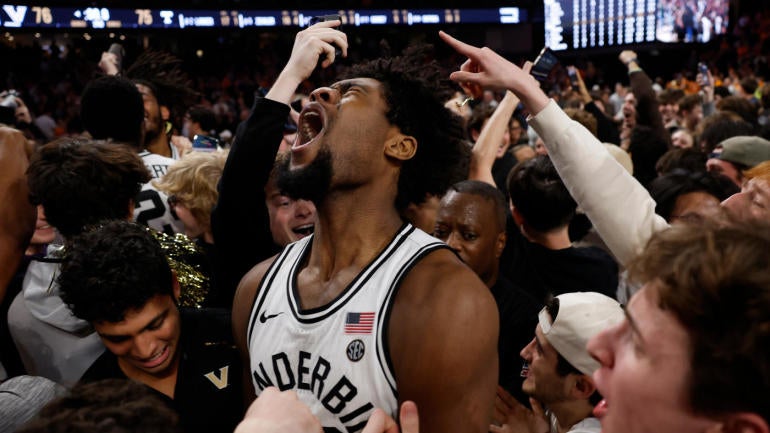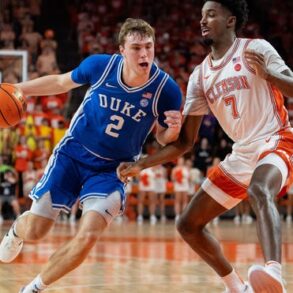
NASHVILLE — Mark Byington has earned the right to take a victory lap and dunk on everyone who doubted him and picked Vanderbilt to finish last in the SEC.
After all, he’s done this before. His first team at James Madison four years ago was picked to finish ninth of 10 teams in the CAA before surging past expectations to share the conference crown.
But even after beating No. 6 Tennessee and No. 9 Kentucky last month to ignite a new surge of “Memorial magic” inside Vanderbilt’s historic but long-dormant Memorial Gymnasium, the Commodores’ first-year coach declined a teed up opportunity to unleash on the doubters.
Instead, he sympathized with them.
“Well, I think it’s difficult to make predictions in college sports right now,” Byington said. “I mean, the rosters are changing dramatically, and no one’s roster changed more dramatically than ours.”
No one’s program has changed more dramatically, either. At least not in the SEC. Vanderbilt finished 9-23 last season with a final NET ranking of 202. The only high-major teams to finish lower in the NET were DePaul, Georgetown and Louisville.
Entering Tuesday’s home showdown with No. 1 Auburn, Byington has Vanderbilt (17-6, 5-5 SEC) projected to make the NCAA Tournament for the first time since 2017 and on pace to finish anywhere but last in the nation’s toughest conference.
His lightning-quick revitalization has forced athletic department officials into a welcome predicament. The Commodores are trying to enact an orderly court-storming process in adherence with SEC rules so they won’t have to fork over any more $500,000 fines.
So, how is the 48-year old former UNC Wilmington guard with no prior SEC experience pulling this off in a historically brutal league?
It all boils down to Byington’s willingness to accept a challenge, a trait that has defined his head coaching career.
“My thing about it was I saw more in them than where they were,” Byington told CBS Sports of what drew him to Vanderbilt. “I love the challenge of trying to turn something around. That’s kind of been what I’ve done where I was previously and where I was previously before that.”
USATSI
Byington’s work as a program architect went mostly unnoticed until James Madison broke through last season with a 32-4 campaign highlighted by a season-opening win at No. 4 Michigan State and a convincing NCAA Tournament victory over No. 5 seed Wisconsin.
But even before JMU became a national darling, Byington was a master of maximizing previously struggling programs. He quickly elevated the Dukes following a seven-year makeover of Georgia Southern, and it turns out his formula for mid-major success is working just fine in the SEC.
That formula includes:
1. Play fast: Vanderbilt is 39th nationally in average possession length.
2. Use a deep rotation: The Commodores are going nine deep in SEC play with all nine players averaging between 15 and 28 minutes.
3. Take care of the basketball: Vanderbilt is turning the basketball over just 9.5 times per game in SEC play, which is third-best in the league.
4. Steal it from opponents: The Commodores are forcing 13.4 turnovers against conference foes, which is tops in the conference.
The formula also includes a flagrant disregard for traditional labels, which is why Byington is the perfect fit at an academically elite institution often pegged as a misfit in the athletics-crazed SEC.
“Sometimes people look at Vanderbilt and they’re going to go ahead and give excuses and say, ‘alright, well, private school, smallest school, whatever tradition.’ It’s one of those things where they put a label on somebody and they would say, ‘well, this is who they are’,”
Count Byington out on that mindset.
“Our mentality is that everything’s new and college athletics is flipped upside down. I mean, right now, Auburn’s the number one team in the country. Auburn basketball wasn’t good 10 years ago, you know? There’s plenty of stories about the landscape changing for different teams for different reasons. And we’ve got to go ahead and be that.”
Nowhere is Byington’s loathing of labels more evident than with the Commodores’ roster, which includes 18 players listed as point guards.
“It’s a little bit of sarcasm,” Byington said. “But at the same time, when you’re a basketball player, you’re a basketball player. We play as modern basketball as anybody. And it’s not just to be modern. I think it’s the right way to play, and I think it fits.”
The mindset was exemplified perfectly in Vanderbilt’s 86-78 win over Texas on Saturday. With just over five minutes remaining and the Commodores clinging to a 66-65 lead, the tallest player in Byington’s rotation, 6-foot-8 Jaylen Carey, pulled down a rebound.
Instead of handing it off to one of the other four “point guards,” any of whom would fit the label more aptly, the 245-pound Carey went coast-to-coast, spinning around one defender and finishing through traffic as part of a game-changing 10-0 run.
“Really, they can call themselves any position they want,” Byington said. “Their skill is going to tell us what they’re allowed to do on the court.”
That’s what Byington loaded his first roster with: skill. North Texas transfer Jason Edwards has emerged as one of the SEC’s most electric scoring guards. Devin McGlockton, A.J. Hoggard and Tyler Nickel also average double figures after transferring from power conference programs.
Then, there’s Carey, who followed Byington from James Madison. In all, Vanderbilt’s rotation features no returning players and just one freshman. As is the case with most first-year coaches, Byington is relying almost entirely on transfers.
“It really was overwhelming,” said Byington, who was introduced at Vanderbilt five days after the transfer portal opened. “What we had to do is try to simplify it.”
What that ultimately entailed was a good bit of detective work beyond the standard film breakdowns and statistical deep-dives. He worked the phones, calling anyone who might know Vanderbilt’s portal targets to get a better sense of their personality traits.
“You had to make sure they’re about the right things,” Byington said. “I think it’s probably more important than ever right now for us to evaluate their character as much as anything.”
Byington didn’t want players who would show up on an SEC campus in the heart of one of the nation’s hottest cities and feel content. He didn’t want players who would sign a nice NIL deal, only for their work ethic to suddenly diminish.
“You’ve got to find people that are really driven to win,” Byington said.
There is mounting evidence that Vanderbilt, as a program, fits the bill of being driven to win. While the Commodores play in a retro gym constructed in 1952, there is nothing old-school about the program’s new headquarters adjacent to Memorial Gymnasium.
The Huber Center, dedicated last month, is a three-story building devoted specifically to Vanderbilt basketball. It includes separate practice gyms for the men’s and women’s programs, locker rooms, player lounges, film space, plush training tables, therapy tubs, ample office space and everything else the Commodores need to incubate a winner.
And if you were going to label the cavernous, state-of-the art weight room that is arguably the facility’s crown jewel, you’d label it as a blue-blood caliber.
“I can say with complete confidence that there is no better basketball facility in the nation,” Vanderbilt athletic director Candice Story Lee said at the facility’s dedication ceremony.
Program sources also push back on the perception that Vanderbilt operates at a significant disadvantage on the NIL front.
There is also plenty to supplement Vanderbilt’s recruiting pitch, in addition to NIL opportunities. Elite academics and the city of Nashville are two great examples.
“Now, are there certain players that don’t fit Vanderbilt?” Byington said. “Yes. But at the same time, I would say that any program has that. There’s certain players that don’t fit who they are and what they are. There’s enough out there who care about their life after basketball and care about academics and who are really good basketball players. We’ve got to find them.”
That’s what Byington did with his hastily assembled 2024-25 roster. Whatever star power the Commodores may lack, they make up for with depth. Vanderbilt ranks No. 33 nationally in bench minutes, per KenPom, and third in the SEC.
Best of all, Byington may not have to construct a total rebuild for 2025-26. Six of Vanderbilt’s top seven scorers are eligible to return.
That’s an important distinction between the first-year regime at Vandy and similarly successful first-year regimes at nearby Louisville and Kentucky. Five of the top six scorers for both the Cardinals and Wildcats are in their final seasons of eligibility, which means both will be headed for significant Year 2 makeovers.
Given what the Commodores could return and what they have shown this season, few will be picking them to finish last in the SEC next season.
But at the end of the day, who really cares? Byington certainly doesn’t. His first Vanderbilt team is showing that preseason polls are nothing more than another meaningless label to shed.
“The natural thing is, if you look at a team and they basically flipped the entire roster, it’s not supposed to work out,” Byington said, putting himself in the mindset of a voter. “If I was in those shoes, I’d have probably done the same thing.”
This post was originally published on this site be sure to check out more of their content.





